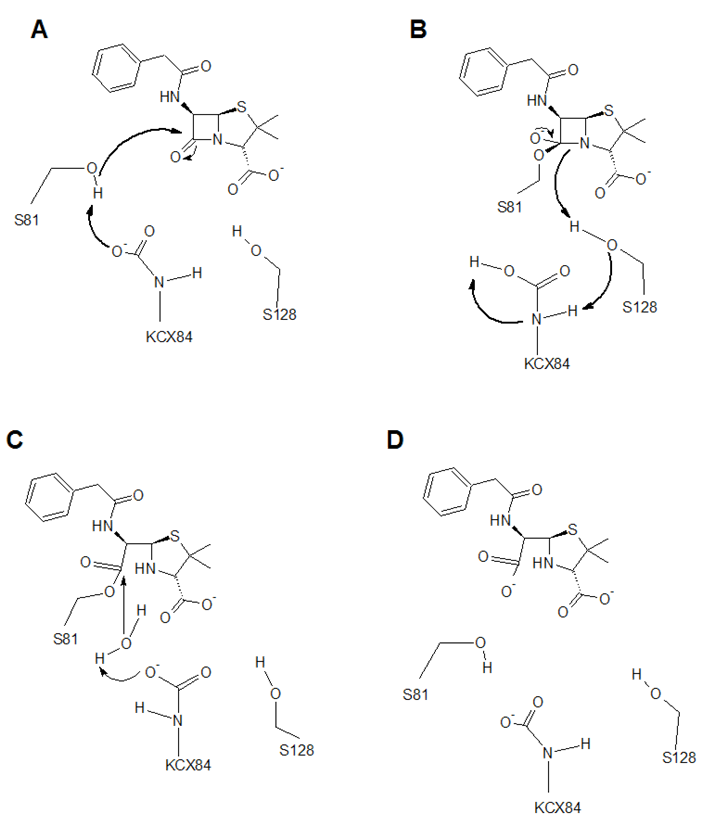Sandbox Reserved 994
From Proteopedia
(Difference between revisions)
| Line 8: | Line 8: | ||
== Bacterial Resistance == | == Bacterial Resistance == | ||
| - | Since the discovery of penicillin by Alexander Flemming, antibiotics have revolutionized the medical world. Penicillin happens to be a β-lactam antibiotic which is characterized by a four-membered β-lactam ring (a cyclic amide). There are | + | Since the discovery of penicillin by Alexander Flemming, antibiotics have revolutionized the medical world. Penicillin happens to be a β-lactam antibiotic which is characterized by a four-membered β-lactam ring (a cyclic amide). There are four classes of β-lactam antibiotics: monobactams, which are the simplest class of β-lactam, and aren’t fused to any rings; penicillins have a thiazole ring fused to the β-lactam; cephalosporin are found with a thiazine ring; lastly, carbapenems are fused with a pyrrole ring and are considered a last line of defense (4). β-lactam antibiotics are the most widely used class of antibiotics because they successfully fight most bacterial infections by inhibiting cell wall synthesis. Their mechanism of action is through inhibition of the transpeptidase enzymes, located in the bacterial cell membrane. Transpeptidase is often referred to as a penicillin-binding protein (PBP) and is responsible for cross-linking the bacterial cell wall <ref>PMCID:PMC162717</ref>. β-lactams mimic the structure of the usual PBP substrate and therefore disrupt the cross-linking process that is critical to cell wall synthesis. Once the β-lactam ring binds, the PBP is irreversibly inactivated. As a result, the bacterial cell wall is compromised, and the bacteria lyse and die (Patrick, 2005). |
Due to overperscription and misuse of antibiotics, bacteria have been able to develop resistance mechanisms. One of these resistance mechanisms is through the expression of β-lactamases. β-lactamases act by cleaving the -lactam ring and render the antibiotic inactive before it has a chance to inhibit the transpeptidase enzymes (Neu, 1992). β-lactamases are grouped into four different classes: A, B, C and D, all of which (besides class B) use a serine based mechanism for destruction of β-lactams. Class B β-lactamases use zinc ions for hydrolysis. In 1980, R.P. Ambler described the first two classes of β-lactamases: Class A and B. Class A were expressed by S. aureus and class B were expressed by B. cereus. Afterwards, Jaurin and Grundstorm observed class C enzymes which hydrolyzes cephalosporins. Class D was distinguished from other serine β-lactamase in the late 1980s, due to having an affinity to oxacillin as its substrate in addition to carbapenems (2). Even more concerning is that the class D β-lactamases, or OXAs, are not inhibited by current clinical β-lactamase inhibitors, such as clavulanic acid. OXA-24 poses a high clinical threat due to its lack of an effective inhibitor. | Due to overperscription and misuse of antibiotics, bacteria have been able to develop resistance mechanisms. One of these resistance mechanisms is through the expression of β-lactamases. β-lactamases act by cleaving the -lactam ring and render the antibiotic inactive before it has a chance to inhibit the transpeptidase enzymes (Neu, 1992). β-lactamases are grouped into four different classes: A, B, C and D, all of which (besides class B) use a serine based mechanism for destruction of β-lactams. Class B β-lactamases use zinc ions for hydrolysis. In 1980, R.P. Ambler described the first two classes of β-lactamases: Class A and B. Class A were expressed by S. aureus and class B were expressed by B. cereus. Afterwards, Jaurin and Grundstorm observed class C enzymes which hydrolyzes cephalosporins. Class D was distinguished from other serine β-lactamase in the late 1980s, due to having an affinity to oxacillin as its substrate in addition to carbapenems (2). Even more concerning is that the class D β-lactamases, or OXAs, are not inhibited by current clinical β-lactamase inhibitors, such as clavulanic acid. OXA-24 poses a high clinical threat due to its lack of an effective inhibitor. | ||
| Line 22: | Line 22: | ||
[[Image:Beta-lactamase resized mechanism.png]] | [[Image:Beta-lactamase resized mechanism.png]] | ||
| + | |||
| + | The mechanism of attack involves a catalytic serine residue, a carboxylated lysine, and another active site serine which contributes to proton movement (A). A high energy tetrahedral intermediate (B) is generated and an acyl enzyme intermediate (C) is formed after the cleavage of the four-membered ring. KCX84 activates the deacylating water which completes the reaction leaving a hydrolyzed β-lactam ring and a regenerated β-lactamase (Powers paper 2013). | ||
== Inhibition == | == Inhibition == | ||
Revision as of 17:35, 20 February 2015
| This Sandbox is Reserved from 20/01/2015, through 30/04/2016 for use in the course "CHM 463" taught by Mary Karpen at the Grand Valley State University. This reservation includes Sandbox Reserved 987 through Sandbox Reserved 996. |
To get started:
More help: Help:Editing |
OXA-24 β-lactamase
| |||||||||||
References
- ↑ Hanson, R. M., Prilusky, J., Renjian, Z., Nakane, T. and Sussman, J. L. (2013), JSmol and the Next-Generation Web-Based Representation of 3D Molecular Structure as Applied to Proteopedia. Isr. J. Chem., 53:207-216. doi:http://dx.doi.org/10.1002/ijch.201300024
- ↑ Herraez A. Biomolecules in the computer: Jmol to the rescue. Biochem Mol Biol Educ. 2006 Jul;34(4):255-61. doi: 10.1002/bmb.2006.494034042644. PMID:21638687 doi:10.1002/bmb.2006.494034042644
- ↑ PMCID:PMC162717


